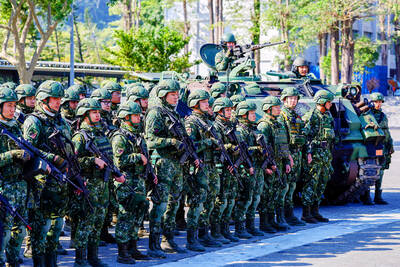Former Taipei mayor and Chinese Nationalist Party (KMT) Vice Chairman Hau Lung-bin (郝龍斌) and other senior party members are publicly differing with KMT Chairwoman Hung Hsiu-chu’s (洪秀柱) interpretation of the so-called “1992 consensus.”
The “1992 consensus” — a term former Mainland Affairs Council chairman Su Chi (蘇起) admitted to making up in 2000 — refers to a supposed understanding between the KMT and the Chinese government that both sides acknowledge there is “one China,” with each side having its own interpretation of what “China” means.
The KMT national congress on Sept. 4 adopted a new policy platform that left out the phrase “one China, with each side having its own interpretation.”
Hung’s amendment to the platform — she says that the “1992 consensus” already contains the idea of “different interpretations” — has been seen as an attempt to move closer to “one China, same interpretation.”
Speaking with members of the US Congress on Sunday in Washington, former premier Hau Pei-tsun (郝柏村) and former National Security Council secretary-general Hu Wei-chen (胡為真) said the idea of there being “one China with different interpretations” is a prerequisite of the “1992 consensus.”
In an earlier interview with Voice Of America, the former premier said that his understanding of the consensus was that there is “one China, with different interpretations,” adding that “the so-called ‘one China’ means the ‘one China’ principle, and that ‘different interpretations’ is that mainland is the People’s Republic of China [PRC] and we are the Republic of China [ROC].”
Former vice president Wu Den-yih (吳敦義) and Hau Pei-tsun’s son, Hau Lung-bin, voiced similar opinions last weekend at the annual meeting of the Taiwan Benevolent Association of America in Boston, Massachusetts, where they spoke about the “1992 consensus” and the associated concept of “one China with different interpretations.”
Wu said that “one China” is inextricably tied to the notion of “different interpretations” and that it is impossible to have only one interpretation or ambiguous interpretations of what “China” means.
“Of course ‘one interpretation’ of China would make everyone happy, but do you think Beijing will accept one nation under the Republic of China constitution?” Wu said.
Hau Lung-bin said that any understanding of the “1992 consensus” necessitates acceptance of the idea of different interpretations of what “China” means, leading observers to speculate that he and Wu were joining hands to take on Hung.
However, KMT Culture and Communications Committee director Chow Chi-wai (周志偉) said the peaceful political platform adopted by the KMT congress is the “1992 consensus” itself, which he said strengthens the importance of the ROC Constitution.
Allowance for different interpretations of what “China” means is part of the tacit understanding that came out of the 1992 meeting that led to the consensus and that therefore this understanding remains in place whether explicitly stated or not, Chow said.

UNILATERAL MOVES: Officials have raised concerns that Beijing could try to exert economic control over Kinmen in a key development plan next year The Civil Aviation Administration (CAA) yesterday said that China has so far failed to provide any information about a new airport expected to open next year that is less than 10km from a Taiwanese airport, raising flight safety concerns. Xiamen Xiangan International Airport is only about 3km at its closest point from the islands in Kinmen County — the scene of on-off fighting during the Cold War — and construction work can be seen and heard clearly from the Taiwan side. In a written statement sent to Reuters, the CAA said that airports close to each other need detailed advanced

Tropical Storm Fung-Wong would likely strengthen into a typhoon later today as it continues moving westward across the Pacific before heading in Taiwan’s direction next week, the Central Weather Administration (CWA) said. As of 8am, Fung-Wong was about 2,190km east-southeast of Cape Oluanpi (鵝鑾鼻), Taiwan’s southernmost point, moving westward at 25kph and possibly accelerating to 31kph, CWA data showed. The tropical storm is currently over waters east of the Philippines and still far from Taiwan, CWA forecaster Tseng Chao-cheng (曾昭誠) said, adding that it could likely strengthen into a typhoon later in the day. It is forecast to reach the South China Sea

Almost a quarter of volunteer soldiers who signed up from 2021 to last year have sought early discharge, the Legislative Yuan’s Budget Center said in a report. The report said that 12,884 of 52,674 people who volunteered in the period had sought an early exit from the military, returning NT$895.96 million (US$28.86 million) to the government. In 2021, there was a 105.34 percent rise in the volunteer recruitment rate, but the number has steadily declined since then, missing recruitment targets, the Chinese-language United Daily News said, citing the report. In 2021, only 521 volunteers dropped out of the military, the report said, citing

WEATHER Typhoon forming: CWA A tropical depression is expected to form into a typhoon as early as today, the Central Weather Administration (CWA) said yesterday, adding that the storm’s path remains uncertain. Before the weekend, it would move toward the Philippines, the agency said. Some time around Monday next week, it might reach a turning point, either veering north toward waters east of Taiwan or continuing westward across the Philippines, the CWA said. Meanwhile, the eye of Typhoon Kalmaegi was 1,310km south-southeast of Oluanpi (鵝鑾鼻), Taiwan’s southernmost point, as of 2am yesterday, it said. The storm is forecast to move through central